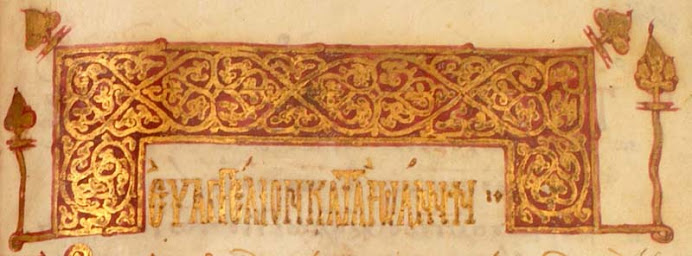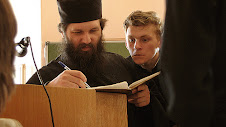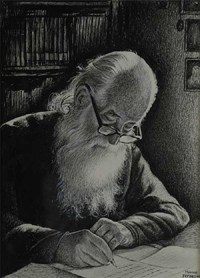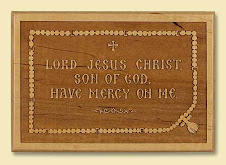
The Image of the Icon: Artist and Iconographer in Tarkovsky’s Andrei Rublev
The viewer’s experience of Andrei Tarkovsky’s film Andrei Rublev is likely to be a varying sense of hypnosis and boredom: at best one can witness the ancient chronicles and illustrated manuscripts come to life, while at worst one might despair of finding any narrative structure or character development in hour after hour of film. Any hope of seeing the life of Andrei Rublev, as might be suggested by the film’s title, is disappointed, as is the hope of discerning a clear parallel between Andrei’s life and Christ’s passion, as the film’s subtitle would seem to indicate. Solzhenitsyn, who disapproved of the film, called it “an impossibly long film filled with extra episodes which have no bearing on the main story.”[1] Nor, for that matter, does one see what one would most expect in a film about Rublev, namely to see him paint icons; for all the talk of icon painting, one never sees Rublev pick up a brush, and the churches and palaces in which we see the monks are notable for their bare, pristine walls. The only icons one sees in the course of the film are those that have just been defiled and burnt by Mongol raiders. Only in the last minutes of the film, with a dramatic change from black and white to color, does one see icons attributed to Rublev, and here too the camera pans over them, showing only isolated detail, leaving the viewer with only glimpses of the icons for which Andrei Rublev is famous. Nonetheless, this is a film about a small group of monastic iconographers, its narrative structure follows them from church to church to paint frescoes, and the film’s climax is a display of icons. The film’s dreamy, hallucinatory fabric and its atmospheric background of fourteenth century Russia serve as the canvas upon which Rublev’s icons are painted.
In an early interview in the newspaper of the Writers’ Union, Tarkovsky clearly expressed his vision of the screenplay:
One must first note that this very project – to “trace the civic portrait of the artist” – is itself both deeply rooted in Marxist ideology and, perhaps unintentionally, undermined by the very representation of the artists depicted in the film. It is, after all, Marxist dogma that the individual is secondary to, and in fact largely formed by, society. It is for this reason that the proper way to change the human person is by social revolution: the new society will create a new man. The character of the artist, therefore, “depends upon his historical situation.” Seen in this way, the triumph of the icon at the end of the film could be taken as evidence for Russia’s fourteenth-century “renaissance,” despite the apparent cruelty and savagery of the society that Tarkovsky depicts. It may be that the film’s deliberately disconnected tableau depiction of medieval Russia, in which Rublev is often relegated to the role of onlooker, is intended to show the individual as inferior to the historical mass. That is, the film’s method might be to show the life of Rublev not by providing a birth to death chronicle of one man’s life, but by providing a panorama of Russian society spanning a quarter century. One wonders, however, if Tarkovsky’s monk-artists themselves do not, in fact, undermine such Marxist doctrine both by their deeply personal, ego-driven aesthetic – recall Theophanes the Greek’s pride, Kirill’s envy of Andrei, and Rublev’s own refusal to paint a fresco of the Dread Judgment in the cathedral in Vladimir – and by their own radical distinction from the society of their time, deeply mired in both violence and pagan sensualism.
The theologically relevant question in this regard is whether Tarkovsky does in fact truly represent the meaning of iconographic art – as defined by the writings of the Fathers that are the standard of Orthodox theology and certainly recognized by Rublev himself as such – in attempting to place the iconographer historically and socially. It is first necessary to define what in fact an “icon” is and what it is not and, consequently what an iconographer is and is not. The Greek word εικων quite simply means image, likeness, and portrait. St. John of Damascus, in his “Defense Against Those Who Attack the Holy Images,” spends considerable time considering the use of the term “image” or “icon” in Christian theology. He illustrates the different roles this key term plays, in Fr. Andrew Louth words, “from characterizing the relationship within the Trinity – the Son as image of the Father, for instance – to describing the way in which God relates to the created order through his divine intentions, images of which are brought into effect through providence, the way in which visual images give us some inkling of invisible realities, the way in which the Old Testament contains images that foreshadow the New, and the way in which images, both in writing and in painting, remind us of past events and people.”[3] In St. John’s extraordinary words, “as the Word became flesh immutably, remaining what it was, so also the flesh became the Word without losing what it was, being rather made equal to the Word hypostatically.”[4] The Word became material, and now material has become the Word. Any symbol pointing to the reality of God is as such an “icon.” As such, an “icon” is both a broader and a narrower concept than normally considered: an icon is much more than a painted image and many painted images are much less than icons. Therefore there is no necessary connection between icon and artist, and consequently no essential connection between artist and his time and place.
While it is clear that an individual painter of icons is a person largely molded by his historical and societal circumstances – the very evolution of iconography attests to this reality – a given image becomes an “icon” in the theological sense only inasmuch as it participates in God: “For just as iron plunged in fire does not become fire by nature, but by union and burning and participation, so what is deified does not become God by nature, but by participation.”[5] As such, the work of the iconographer is deliberately de-personalized: he neither signs his icons nor seeks to express personal creativity, but rather conforms to canonical rules of depiction. The iconographer is not – or, in any case, should not be – an individualistic artist defined by his time and place.
In an early interview in the newspaper of the Writers’ Union, Tarkovsky clearly expressed his vision of the screenplay:
I link my creative plans to the question of the artist’s relationship to the nation and his time, where the artist does not exist in isolation, but is the conscience of society, the pinnacle of its imagination, and the mouthpiece of its talent. These issues are the basis of the screenplay The Passion According to Andrei which I am currently writing together with Andrei Konchalovsky.While one must grant that Tarkovsky, speaking during the reign of Khrushchev, was attempting to explain his work in terms compatible with Marxist ideology – hence the mandatory nod to Lenin – his basic intention to depict the “artist’s place in the life of the nation” can certainly be taken as an extremely broad but nonetheless accurate description of the film. How well does Tarkovsky in fact succeed in this portraying this depiction?
This screenplay tells of the life of the genius Russian artist, Andrei Rublev, whose memorialisation was urged by Vladimir Lenin in his first decrees.
The problems of the Russian renaissance, about which we unfortunately know practically nothing, help us to trace the civic profile of the artist and isolate the significant point at which several planes coincide: time, history, the ethical ideal, the artist, and the nation. Our film about Andrei Rublev will tell of the impossibility of creating art outside of the nation’s aspirations, of the artist’s attempts to express its soul and character, and of the way that an artist’s character depends upon his historical situation. The question of the artist’s place in the life of the nation seems to us one of the most contemporary and important questions on the cusp of the future.[2]
One must first note that this very project – to “trace the civic portrait of the artist” – is itself both deeply rooted in Marxist ideology and, perhaps unintentionally, undermined by the very representation of the artists depicted in the film. It is, after all, Marxist dogma that the individual is secondary to, and in fact largely formed by, society. It is for this reason that the proper way to change the human person is by social revolution: the new society will create a new man. The character of the artist, therefore, “depends upon his historical situation.” Seen in this way, the triumph of the icon at the end of the film could be taken as evidence for Russia’s fourteenth-century “renaissance,” despite the apparent cruelty and savagery of the society that Tarkovsky depicts. It may be that the film’s deliberately disconnected tableau depiction of medieval Russia, in which Rublev is often relegated to the role of onlooker, is intended to show the individual as inferior to the historical mass. That is, the film’s method might be to show the life of Rublev not by providing a birth to death chronicle of one man’s life, but by providing a panorama of Russian society spanning a quarter century. One wonders, however, if Tarkovsky’s monk-artists themselves do not, in fact, undermine such Marxist doctrine both by their deeply personal, ego-driven aesthetic – recall Theophanes the Greek’s pride, Kirill’s envy of Andrei, and Rublev’s own refusal to paint a fresco of the Dread Judgment in the cathedral in Vladimir – and by their own radical distinction from the society of their time, deeply mired in both violence and pagan sensualism.
The theologically relevant question in this regard is whether Tarkovsky does in fact truly represent the meaning of iconographic art – as defined by the writings of the Fathers that are the standard of Orthodox theology and certainly recognized by Rublev himself as such – in attempting to place the iconographer historically and socially. It is first necessary to define what in fact an “icon” is and what it is not and, consequently what an iconographer is and is not. The Greek word εικων quite simply means image, likeness, and portrait. St. John of Damascus, in his “Defense Against Those Who Attack the Holy Images,” spends considerable time considering the use of the term “image” or “icon” in Christian theology. He illustrates the different roles this key term plays, in Fr. Andrew Louth words, “from characterizing the relationship within the Trinity – the Son as image of the Father, for instance – to describing the way in which God relates to the created order through his divine intentions, images of which are brought into effect through providence, the way in which visual images give us some inkling of invisible realities, the way in which the Old Testament contains images that foreshadow the New, and the way in which images, both in writing and in painting, remind us of past events and people.”[3] In St. John’s extraordinary words, “as the Word became flesh immutably, remaining what it was, so also the flesh became the Word without losing what it was, being rather made equal to the Word hypostatically.”[4] The Word became material, and now material has become the Word. Any symbol pointing to the reality of God is as such an “icon.” As such, an “icon” is both a broader and a narrower concept than normally considered: an icon is much more than a painted image and many painted images are much less than icons. Therefore there is no necessary connection between icon and artist, and consequently no essential connection between artist and his time and place.
While it is clear that an individual painter of icons is a person largely molded by his historical and societal circumstances – the very evolution of iconography attests to this reality – a given image becomes an “icon” in the theological sense only inasmuch as it participates in God: “For just as iron plunged in fire does not become fire by nature, but by union and burning and participation, so what is deified does not become God by nature, but by participation.”[5] As such, the work of the iconographer is deliberately de-personalized: he neither signs his icons nor seeks to express personal creativity, but rather conforms to canonical rules of depiction. The iconographer is not – or, in any case, should not be – an individualistic artist defined by his time and place.
[1] “Fil’m o Rubleve,” Publitsistika. V trekh tomakh (Iaroslavl’: Verkhniaia Volga, 1997), vol. 3, p. 164. Quoted in Robert Bird, Andrei Rublev (London: British Film Institute, 2004), 37.
[2] “Eto ochen’ vazhno,” Literaturnaia gazeta, September 20, 1962, p. 1. Quoted in Bird, 24.
[3] Andrew Louth (tr.), Three Treatises on the Divine Images (Crestwood, NY: St. Vladimir’s Seminary Press, 2003), 10.
[4] Ibid., 22.
[5] Ibid., 33.
[2] “Eto ochen’ vazhno,” Literaturnaia gazeta, September 20, 1962, p. 1. Quoted in Bird, 24.
[3] Andrew Louth (tr.), Three Treatises on the Divine Images (Crestwood, NY: St. Vladimir’s Seminary Press, 2003), 10.
[4] Ibid., 22.
[5] Ibid., 33.









1 comment:
How can I contact the screenwriter?
Post a Comment